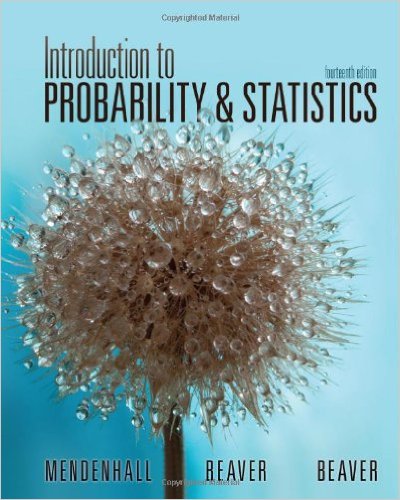
| Evaluations/Important Dates: | ||
| Exam I (20%) | Monday, February 15 | |
| Exam II (20%) | Monday, April 04 | |
| Mini Project I(10%): | Due Feb 24 | |
| Mini Project II(10%): | Due April 13 | |
| Homeworks (15%) | TBD | |
| Final Exam (25%) | Monday, April 25(3:00PM-6:00PM) | |
| Letter Grade | E | D- | D | D+ | C- | C | C+ | B- | B | B+ | A- | A | A+ |
| Percentage | 0-59 | 60-62 | 63-66 | 67-69 | 70-72 | 73-76 | 77-79 | 80-82 | 83-86 | 87-89 | 90-92 | 93-96 | 97-100 |
| Date | Sections | Topics covered | Remarks |
| January 6 | Review of Confidence Interval | ||
| January 11 | 9.3 | A large-sample test about population mean | Rlab |
| January 13 | 9.4 | Difference between population means | |
| January 18 | No class | MLK DAY | |
| January 20 | 10.3,10.4 | Small -sample inference: independent sample test | |
| January 25 | 10.4. 10.5 | Small -sample inference: independent and paired-difference test | |
| January 27 | 10.6, 10.7 | Comparing two population variances | |
| February 1 | 11.1-11.4 | Introduction: Analysis of Variance | |
| February 3 | 11.5 | Completely randomized design | |
| February 8 | 11.7 | Randomized block design | |
| February 10 | 11.8 | ANOVA for a randomized block design | |
| February 15 | Exam 1 | ||
| February 17 | 11.10 | Factorial experiment | |
| February 22 | 12.1-12.4 | Linear regression | |
| February 24 | 12.5 | The coefficient of determination | |
| February 29- March 04 | Break | ||
| March 07 | 12.6 | Estimationa and prediction using the fitted line | |
| March 09 | 13.1-13.3 | Multiple linear regression | |
| March 14 | 13.4 | Polynomial regression model | |
| March 16 | 13.5 | Qualitative predictor variables in a regression | |
| March 21 | 13.6 | Testing and training sets of regression coefficients | |
| March 23 | 14.1-14.3 | Goodness of fit-test | |
| March 28 | 14.4 | A two-way classification | |
| March 29 | 14.5 | Comparing several multinomial populations | |
| April 4 | Exam 2 | ||
| April 6 | 15.1-15.3 | The wilcoxon rank sum test | |
| April 11 | 15.5 | The wilcoxon rank sum test: paired experiment | |
| April 13 | 15.6 | Kruskal-Wallis test | |
| April 18 | Review | ||
| April 25 | Final Exam (3:00AM- 6:00 PM) |
| Description | Remarks | |
| Ex 9.3 : 9.1, 9.3, 9.4, 9.6, 9.8, 9.15, 9.16 Ex 9.4: 9.18, 9.22, 9.28 | Due Jan 25 | |
| Ex 9.5: 9.31, 9.35, 9.38, 9.41 9.42, 9.45, 9.50, 9.51 | Due Wed Feb 03 | |
| Ex9.6: 9.42, 9.46 Ex 10.3: 10.2, 10.3, 10.6 Ex 10.4: 10.18, 10.19, 10.27, 10.30 Ex 10.5: 10.36, 10.41, 10.46 | Wed, feb 10th | |
| Ex 10.6: 10.49, 10.51, 10.53, 10.55, 10.56 Ex 10.7: 10.58, 10.10.59, 10.61, 10.10.63, 10.66 | Exam 1 covers up to section 10.7 | |
| Ex 11.5:: 11.1, 11.2, 11.7,11.12, 11.1411.18 Ex11.8:: 11.28, 11.33, 11.36, 11.37,11.4011.43 Ex11.10:: 11.45, 11.49, 11.5011.52 | Quiz from exercise 11.5 on Match 07th. | |
| Ex 12.4:: 12.1, 12.3, 12.7, 12.9, 12.12, 12.15, Ex12.5:: 12.19, 12.20, 12.23, 12.24, 12.28, 12.30 Ex12.6 :: 12.34, 12.36, 12.38 EX12.7:: 12.40, 12.42, 12.44, 12.45, 12.46 | Quiz on march 16th and HW Due March 16th | |
| Ex 13.4: 13.1, 13.3, 13.5, 13.10, 13.12, 13.15 ExEx13.5: 13.17, 13.18, 13.20, 13.22, 13.24 | this will be a part of exam 2 |
| Description | Remarks | |
| review: Hypothesis Testing | ||
| Data Visualization | ||
| Measures of Data | ||
| Normal Distribution | ||
| Central Limit Theorem | ||
| Book Data | Download |